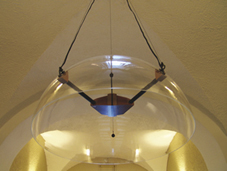Yan Jun
Music for Listening on the Moon (2010)
“I received a commission for Music for Listening on the Moon from an art project. I decided to make it as a continuation of my last album, Wormhole Trip Ost Music for Time and Space Travel, which is based on my site-specific installation Wormhole Trip Souvenir. I now have a new installation in my washroom, which I call Wormhole 2. There is 60 minutes material from the installation, which was recorded from two pipes in the washroom via contact microphones, some tiny sounds plus electric current noises. After some compression, normalizing and noise-reduction I realized it was enough for Music for Listening on the Moon, since it will be a chance to listen to sound itself and forget music. But I did a little bit more modulation, then got the second version. I think it’s a kind of minimal musique-concrete for Listening to Music on the Earth, where we still need flavoring in our life. I’m not interested in science-fiction, I’m interested in reality, which is about creating an event by listening. My works are not intended to comfort or entertain people. I would like to confuse, hurt or isolate them, though sometimes it’s funny and entertaining anyway. The reason I chose the sounds from pipes in washroom is that it’s always satisfying to sit and listen to any tiny unknown sound at home. The earth and the moon: two potential situations for listening and thinking the tiny difference between reality and real. The simple compression and modulation: what does field recording/reality mean? What does composition/music mean? And why not listen to my digital recorder? It produces beautiful basic noise, and it’s free.”
The first version was released on Sub Jam / Kwanyin Records as Music for Listening on the Moon. The second version will be released later on Japanese label SPEKK.
Yan Jun was born in Lanzhou in 1973, now based in Beijing. B.A. of Chinese Literature. Yan's live performance engages space feedback, loop and voice/language to make hypnotic noise. He uses concepts of recycling, feedback and reduction to create sound art work, which relates to field recording, installation, image, video, publishing and multiple forms. He performed and participated in exhibitions in Paris (Nuit Blanche), Amsterdam, Berlin (Transmediale), Cologne (MusikTriennale Köln), Moers (Moers Festival), Kuala Lumpur (Street Roar), Seoul (Bulgasari), Oslo (Sound of Mu), Brussels, Copenhagen (Metropolis Biennale), toured in Taiwan and Mainland China. He has also initiated Tie Guan Yin and Pisces Iscariots, two free-form electro-acoustic impro projects. On the 15th of October in 2000, the Tree Village Declaration (written by Yan Jun and which was discussed with members of a number of bands) was finally read by Yan Jun as an amended versionon in the Garden of Joy at a show of Tongue and other bands. The statement, called "Tree Village Declaration" was subsequently signed by almost all the active bands and musicians of the rock scene at that time, who thereby denounced further cooperation with the movie Beijing Rocks. He was a well-known music critic and organizer as a driving force of China's underground music and sub-culture scene before he turned his focus into contemporary music and sound art in 2004. Yan runs the virtual creation Sub Jam since 1998. It has released some essential underground music and independent films. In 2004 he co-founded Kwanyin Records for experimental music and sound exploration. He runs Waterland Kwanyin, a weekly event of experimental / improv music and sound art since 2005, and the annual outdoor festival Mini Midi. He also curates sound projects for DIAF Art Festival since 2004, and GetItLouder07.
In June 2006, Yan Jun started the avantgarde concert series 1+ which run for about 21 times before it stopped in Spring 2007.
He has published 6 books on the topic of Chinese new music and 3 poetry anthologies.
04.10. - 16.12.12
|

